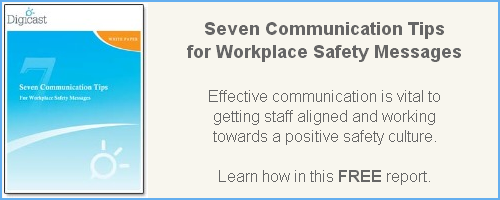 If you're reading this article, you know that any decent health and safety training manual has to include information such as personal protective equipment (PPE), emergency evacuation, incident reporting and so on.
If you're reading this article, you know that any decent health and safety training manual has to include information such as personal protective equipment (PPE), emergency evacuation, incident reporting and so on.
After reading hundreds of safety induction manuals from companies, most companies get away with only including information from a compliance standpoint. This really is the bare minimum. While it might protect you legally, the truth is companies that are excellent at safety see their health and safety manuals differently. For a great safety performance culture, Health and Safety Manuals need to also include information that encourages your staff to work together on safety and understand why safety must be considered in all their decisions. The following is a list of information that will take your health and safety performance to the next level (but if you're happy with the bare minimum and just want to improve you Health and Safety manuals, then read 5 Mistakes Companies Make with their Standard Operating Procedures):
- Whistle-blower policies - One of the three key areas that we recommend companies need to get right, in order to have a high functioning culture, is to ensure that people feel safe. This safety needs to be two-fold - safety in speaking up and working in a safe environment. When staff feel safe to talk about issues, can offer suggestions and know that they are free from harm at work, they trust that the company cares for them (and so they'll work hard rather than just try to survive without issues, you can read more at 3 Factors that Influence Workplace Culture). However, there are some managers that work in such a way that their department might not feel free to speak up, thereby allowing dodgy workplace practices to exist (bribery, sexual harrassment, ignoring workplace hazards etc) in one department alone. Companies must assign a dedicated person who can be contacted when anyone has a problem that they do not feel that they can discuss with their manager (who could be part of the problem). For really large companies, a dedicated hotline is invaluable where anyone from any level can bring up a complaint and know that they will not lose their job or be bullied. Mandatory whistle blowing policies need to put in place that protect employees, and who can rely on their complaints being investigated. Employers must thoroughly investigate any complaint or allegation both with anonymity and complete confidence. Any complaint raised must be taken seriously. Otherwise, shocking workplace practises can flourish, read How a Culture of Fear Breeds Dodgy Workplace Practices for more).
- Align staff to conduct standards - Companies always put their conduct standards into safety manuals, but they often read like a complaint list from a school principal. Your conduct standards are an opportunity to align staff to your culture and what your company stands for. Rather than discussing the 'how" and "what" about company safety, start explaining "why". Why is safety important to how you do business? Why is safety integral across all departments? Stories or metaphors are the best in reaching out to staff to explain why safety is important to the company and them. For example, if integrity is your core value then talk about the importance of integrity and how leaving a ladder out for people to trip over is not how you operate. Humanise conduct standards so that they are friendly and clearly explain how you operate as a company and giving examples, where you can. Consider making your conduct standards a visual document that is more appealing than text alone. For example, we have been working with companies to create infographics that provide the information as pictures rather than words. Another alternative is to create safety training videos that visually explains your safety policy.
- Conduct for Supervisors- Supervisors are linchpins when it comes to safety in any organisation. Positive communication relations between supervisors and employees improves safety performance & staff productivity. They enable staff to freely raise safety concerns, resulting in fewer accidents, provided that management takes action on the safety issues. They also foster positive safety attitudes. All supervisors need great people skills to enable their staff to want to talk to them about issues. Consider creating codes of conduct for supervisors that request that will be positive about safety, communicate openly with frontline staff and senior management, as well as empathise with staff about any complaints (see our Supervisor Toolbox Training sessions for more information).
- The importance of teamwork - Safety manuals are often very good at letting people know what they can't do, from a process perspective. But they are often light on information that helps people understand how staff must work together to communicate about safety. When you boil it all down, having everyone working as one team and co-operating goes along way towards improving safety. If everyone cares for each other, then looking out for safety issues becomes second nature. Include references to other people, photos of team-mates, information on how people work together on safety, how you expect staff to contribute in toolbox meetings, or video content that show your staff discussing hazards. Explain the need for safety to be integrated into all decisions and that all departments are responsible for safety and must work together.
- Be friendly - A lot of companies tend to write safety manuals that are written from a legal protection stance rather than from an actually wanting to protect staff perspective. Write the manual like you're talking to your best friend or child. Write it from the perspective that you care. This is no time to sound like a lawyer. Avoid negative language. For example: "Don't panic" is best written as "Remain calm".
- Use photos and images liberally- According to Dr John Medina, the author of Brain Rules, reading is inefficient as we have to identify certain features in the letters to be able to read them. Your brain interprets every letter as a picture. This takes take time to read. It also means that lots of words shown on say, a PowerPoint slide, chokes your brain.
We are more likely to recall visual information and we are amazing at remembering pictures. This is possibly because in the olden days it was important to know whether we could eat something or whether we needed to look around to see if something wanted to eat us.
Recognition soars with pictures. In fact, recognition almost doubles for a picture compared to text.

Use photos, videos and images to really explain information. Manual handling is a great example. It's very difficult to explain how to correctly lift a box in words (which many companies try to do, rather unsuccessfully). While it is possible, you'll find it won't engage. Using video is the best way, with images of staff lifting the right way the next best (read How to improve Manual Handling Training and Awareness for more).
At a minimum, Health and Safety manuals need to explain basic safety policies in a range of areas. That might be suitable for legal reasons, but for best effect, organisations need to take it a step further. Health and Safety manuals should be seen an avenue to really explain how safety integrates into all departments, is important in all decisions and why safety is important to the company. This way staff will be aligned to the company values, importance of safety and working with others to improve safety and being accountable for their own personal safety.
What can you do to improve your health and safety manuals?

Image Credit: Green whistle, Flickr, stevendepolo

 If you're reading this article, you know that any decent health and safety training manual has to include information such as personal protective equipment (PPE), emergency evacuation, incident reporting and so on.
If you're reading this article, you know that any decent health and safety training manual has to include information such as personal protective equipment (PPE), emergency evacuation, incident reporting and so on.

